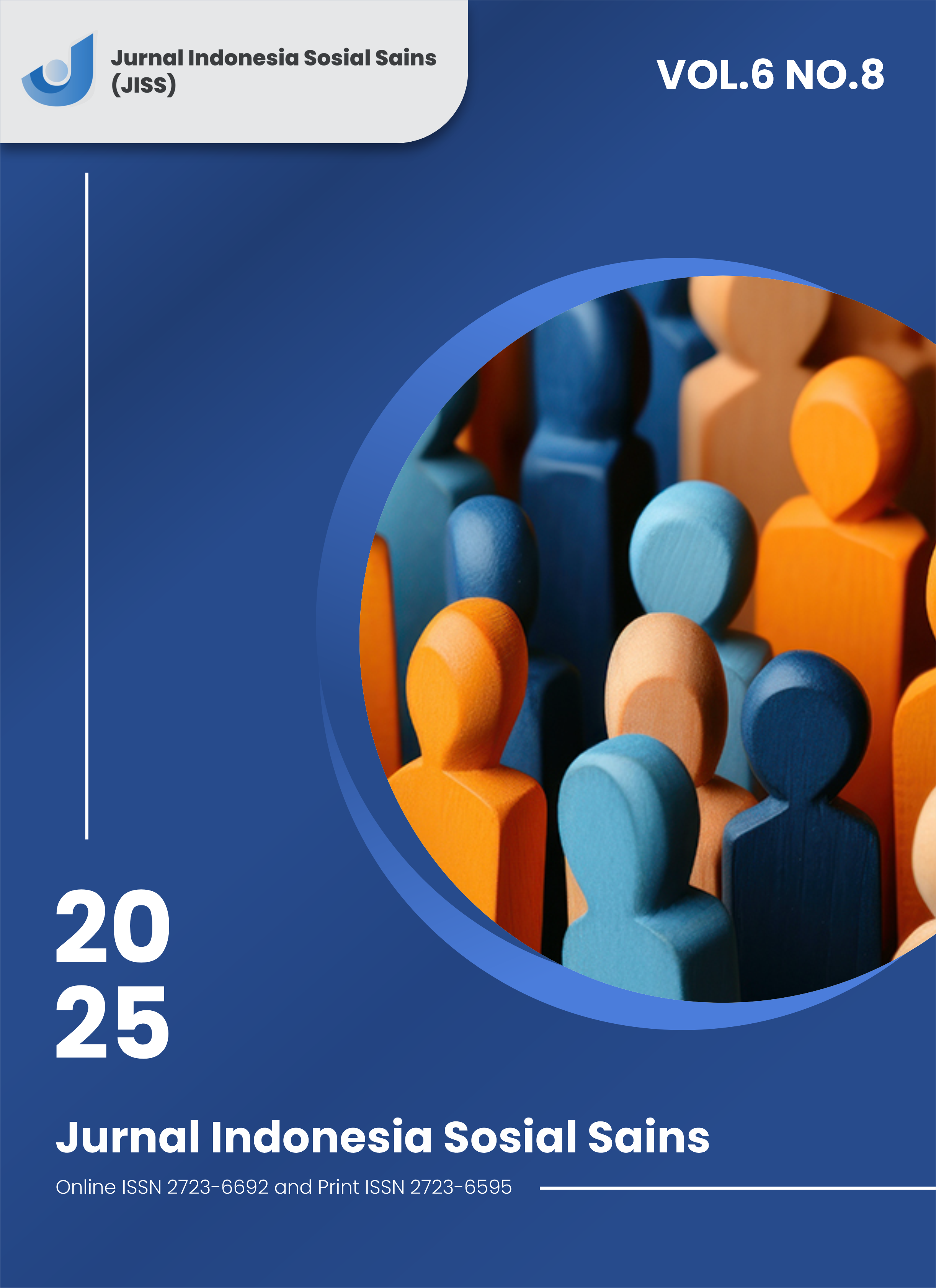Prevalence of Hyperemesis Gravidarum Based on Age, Parity, and Severity
DOI:
https://doi.org/10.59141/jiss.v6i8.1806Keywords:
Age, Degree of Severity, Hyperemesis GravidarumAbstract
Hyperemesis gravidarum is a persistent nausea and vomiting which is the main cause of hospitalization after preterm delivery in all the pregnancies. Globally, the prevalence of hyperemesis gravidarum is 12.5% and the prevalence of hyperemesis gravidarum in North Maluku is around 3.66%. To describe the incidence of hyperemesis gravidarum at RSUD Dr. H. Chasan Boesoirie. The type of research is a retrospective descriptive observational approach with a total sampling technique of 94 patients. Data were collected from medical record data according to the inclusion and the exclusion criteria and it is used univariate analysis. Patients at risk for hyperemesis gravidarum based on the age, namely 20-35 years, were 78 patients (84.8%), then based on parity at risk, namely multigravida, 45 patients (48.9%) and based on the degree of severity who were at risk of being affected, namely 59 patients (64.1%). The majority of the pregnant women are affected by hyperemesis gravidarum, namely at the age of 20-35 years, the multigravida parity and the moderate degree.
References
Aiman, U. (2019). Hubungan paritas dengan kejadian hiperemesis gravidarum di RSUD Salatiga. Universitas Ngudi Waluyo, 8(5), 55.
Aminu, M. B., Alkali, M., Audu, B. M., Abdulrazak, T., & Bathna, D. (2020).Prevalence of hyperemesis
Fiaschi, L., Nelson-Piercy, C., & Tata, L. J. (2016). Hospital admission for hyperemesis gravidarum: a nationwide study of occurrence, reoccurrence and risk factors among 8.2 million pregnancies. Human Reproduction, 31(8), 1675–1684.gravidarum and associated risk factors among pregnant women in a tertiary health facility in Northeast, Nigeria. International Journal of Reproduction, Contraception, Obstetrics and Gynecology, 9(9), 1770–2320.
Aprilasari, M. (2022). Hubungan usia ibu hamil dan paritas dengan hiperemesis gravidarum di Wilayah Kerja Puskesmas Padas Kabupaten Ngawi. 10(4).
Arisdiani, T., & Hastuti, Y. (2020). Tingkat hiperemesis gravidarum pada ibu hamil trimester 1.
Atika, I., Putra, H. K., & Thaib, S. H. (2016). Hubungan hiperemesis gravidarum dengan usia ibu, usia gestasi, paritas, dan pekerjaan pada pasien rawat inap di RSUP Dr. Moh. Hoesin Palembang. Jurnal Kedokteran dan Kesehatan, 3(3), 166-171.
Atiqoh, R. N. (2020). Kupas tuntas hiperemesis gravidarum (mual muntah berlebih dalam kehamilan).
Leny. (2020). Hubungan antara umur dan paritas dengan kejadian hiperemesis gravidarum pada ibu hamil. Jurnal Kebidanan: Jurnal Medical Science Ilmu Kesehatan Akademi Kebidanan Budi Mulia Palembang.
Leveno, K. J. (2016). Manual komplikasi kehamilan Williams (23rd ed.). Buku Kedokteran EGC.
MacGibbon, K. W. (2020). Hyperemesis gravidarum: Strategies to improve outcomes. Journal of Infusion Nursing, 43(2), 78–96.
Mariyah, S., Hernawati, E., & Liawati. (2022). Perbedaan tingkat mual dan muntah pada ibu hamil trimester 1 dengan hiperemesis gravidarum sebelum dan sesudah diberikan rebusan jahe di klinik sehat medika tahun 2021. Jurnal Kesehatan Rajawali, 12(1), 12–15.
Nurmi, M., Rautava, P., Gissler, M., Vahlberg, T., & Polo‐Kantola, P. (2020). Incidence and risk factors of hyperemesis gravidarum: a national register‐based study in Finland, 2005‐2017. Acta Obstetricia et Gynecologica Scandinavica, 99(8), 1003–1013.
Noviana, A. D., Diah, E. N., & Mariati. (2022). Hubungan usia, paritas dan tingkat hiperemesis gravidarum terhadap lama perawatan pada pasien hiperemesis gravidarum di RSUD Dr. M Yunus Bengkulu Tahun 2021. Jurnal Ilmiah Kebidanan (The Journal Of Midwifery), 10(1), 67–72.
Oktavia, L. (2016). Kejadian hiperemesis gravidarum ditinjau dari jarak kehamilan dan paritas. Jurnal Ilmu Kesehatan Aisyah, 41–45.
Paskana, K., & Gusnidarsih, V. (2020). Hubungan paritas dengan kejadian hiperemesis gravidarum pada Ibu hamil.
Purwanti, M., Brahmana, N. E., & Hidayat, W. (2020). Faktor risiko umur, gravida, status gizi dan kehamilan ganda dengan kejadian hiperemesis gravidarum. Jurnal Muara Sains, Teknologi, Kedokteran dan Ilmu Kesehatan, 3(2), 237.
Rudiyanti, N., & Rosmadewi. (2019). Hubungan usia, paritas, pekerjaan dan stress dengan emesis gravidarum di Kota Banda Lampung. Jurnal Ilmiah Keperawatan Sai Betik.
Salsabila, V. L., Hasanah, N., & Ngo, N. F. (2022). Literature review tentang hubungan psikologis terhadap kejadian hiperemesis gravidarum. Jurnal Sains dan Kesehatan, 4(1), 89–98.
Utama, Y. K., Rachmawati, & Hartini, L. (2021). Hubungan paritas dengan kejadian emesis gravidarum pada ibu hamil trimester 1 di Puskesmas Anggut Atas Kota Bengkulu Tahun 2020.
Vikanes, Å., Skjærven, R., Grjibovski, A. M., Gunnes, N., Vangen, S., & Magnus, P. (2010). Recurrence of hyperemesis gravidarum across generations: population based cohort study. Bmj, 340.
Downloads
Published
How to Cite
Issue
Section
License
Copyright (c) 2025 Sarah Chaerani Salsa Bella, Syamsul Bahri M.S. Idris, Prita Aulia M. Selomo

This work is licensed under a Creative Commons Attribution-ShareAlike 4.0 International License.
Authors who publish with this journal agree to the following terms:
- Authors retain copyright and grant the journal right of first publication with the work simultaneously licensed under a Creative Commons Attribution-ShareAlike 4.0 International. that allows others to share the work with an acknowledgement of the work's authorship and initial publication in this journal.
- Authors are able to enter into separate, additional contractual arrangements for the non-exclusive distribution of the journal's published version of the work (e.g., post it to an institutional repository or publish it in a book), with an acknowledgement of its initial publication in this journal.
- Authors are permitted and encouraged to post their work online (e.g., in institutional repositories or on their website) prior to and during the submission process, as it can lead to productive exchanges, as well as earlier and greater citation of published work.












